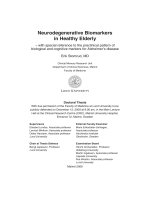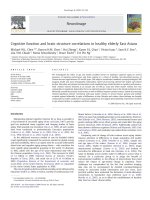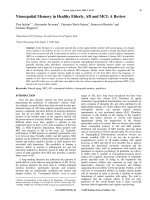Memory performance in healthy elderly without Alzheimer’s disease: effects of time and apolipoprotein-E pptx
Bạn đang xem bản rút gọn của tài liệu. Xem và tải ngay bản đầy đủ của tài liệu tại đây (150.55 KB, 7 trang )
Memory performance in healthy elderly without Alzheimer’s disease:
effects of time and apolipoprotein-E૾
Richard Mayeux MD, MSc
a,b,d,e,f,
*, Scott A. Small MD
a,b,e
, Ming-Xin Tang, PhD
a,g
,
Benjamin Tycko, MD, PhD
c,e
, Yaakov Stern, PhD
a,b,d,e
a
Gertrude H. Sergievsky Center, School of Public Health, Columbia University College of Physicians and Surgeons, New York, New York, USA
b
Department of Neurology, School of Public Health, Columbia University College of Physicians and Surgeons, New York, New York, USA
c
Department of Pathology, School of Public Health, Columbia University College of Physicians and Surgeons, New York, New York, USA
d
Department of Psychiatry, School of Public Health, Columbia University College of Physicians and Surgeons, New York, New York, USA
e
Taub Institute for Research in Alzheimer’s Disease and the Aging Brain, School of Public Health, Columbia University College
of Physicians and Surgeons, New York, New York, USA
f
Division of Epidemiology, School of Public Health, Columbia University College of Physicians and Surgeons, New York, New York, USA
g
Division of Biostatistics, School of Public Health, Columbia University College of Physicians and Surgeons, New York, New York, USA
Received 4 December 2000; received in revised form 4 December 2000; accepted 30 January 2001
Abstract
Transgenic mice expressing human APOE-4 develop an age-dependent decline in memory without pathological features of Alzheimer’s
disease (AD). This implicates APOE in the maintenance of memory during normal senescence, but parallel human studies are limited
because longitudinal investigations of memory usually do not exclude patients with AD or “questionable” AD (QD). The current study
examined the effect of APOE on cognitive function over time in elderly without dementia. We hypothesized that, compared to other APOE
alleles memory decline even in healthy elderly would be greater among those with an APOE-4.
The results of neuropsychological tests, grouped into domains of memory, language and visuospatial/cognitive function by factor
analysis, were examined at three intervals over a seven-year period in 563 healthy elderly without AD or QD using generalized estimating
equations. Memory performance declined over time, while scores on the visuospatial/cognitive and language factors did not change.
Increased age was associated with lower scores, and higher education with higher scores on all factors at each interval. No APOE allele was
associated with performance on a specific cognitive factor at any interval, but the presence of an APOE-4 allele was associated with a more
rapid decline in the memory factor over the follow-up period. The effect was most pronounced among individuals with less than 10 years
of formal education. There was no similar time-dependent relationship between APOE-4 and the language or visuospatial/cognitive factors.
Transgenic mice and elderly humans without AD or QD expressing APOE-4 show a decline in memory performance over time. These
observations provide evidence for an APOE-specific effect on memory during senescence. © 2001 Elsevier Science Inc. All rights reserved.
1. Introduction
APOE-4 is the major known genetic risk factor for
late-onset familial and sporadic AD. Several mechanisms
have been proposed to explain how APOE-4 increases AD
risk. APOE may be an active participant in

-amyloid
clearance [25,30,40]. APOE deficient mice expressing the
APP
717
mutation that causes an early-onset, autosomal
dominant form of AD deposit a greater number of amyloid
plaques [1] and show more pronounced memory impair-
ment than wildtype mice [16]. A direct role for APOE,
independent of an interaction with

-amyloid, involving
both biochemical and neuronal integrity has been suggested
in animal models with impaired memory [16,20]. Compared
with intact mice, APOE deficient mice have decreased syn-
aptic density in cholinergic, noradrenergic and serotinergic
projections to relevant brain regions [13] and perform worse
in several types of memory tasks [8,16,42,43]. These pro-
posed mechanisms have been supported, in part, by parallel
studies in humans. APOE-4 is associated with greater

-amyloid plaque density than other APOE alleles among
patients with AD [24,49]. Compared to individuals with
૾This research was supported by federal grants AG08702, AG07232,
and AG01963.
* Corresponding author. Tel.: ϩ1-212-305-2391; fax: ϩ1-212-305-
2518.
E-mail address: (R. Mayeux).
www.elsevier.com/locate/neuaging
Neurobiology of Aging 22 (2001) 683–689
0197-4580/01/$ – see front matter © 2001 Elsevier Science Inc. All rights reserved.
PII: S0197-4580(01)00223-8
other APOE genotypes, individuals with an APOE-4 allele
develop hippocampal atrophy [31,33,35,44,50,65] and are
more likely to have cognitive impairment [2,5,6,11,12,15,
18,21,22,29,39,50,53,68]. Whether APOE-4 has a direct
effect on memory in the absence of disease, or acts only
through its association with AD, remains unknown because
the majority of studies have been either cross-sectional or
have not excluded individuals with QD. The few longitudi-
nal studies have provided divergent results [15,29,56]. We
designed a series of analyses of data collected in a longitu-
dinal study to determine whether or not APOE influences
memory and other cognitive functions in individuals who
are free of dementia or cognitive impairment.
2. Methods
2.1. Subjects and Setting
Data were included from individuals participating in a
prospective study of 2,126 Medicare recipients, 65 years
and older, residing in a single community in Northern Man-
hattan. Each person received the same medical, neurological
and neuropsychological evaluations at regular intervals. The
cohort was followed over a 7-year period beginning in 1992.
Three follow-up examinations took place at 20-month in-
tervals after the baseline interview. Over the study period,
the annual mortality rate has been 8.1%, the overall refusal
rate has been 10% and the annual incidence rate of AD has
been 3% [63].
In order to address the study hypothesis, we included
data only from 563 individuals without dementia (AD or
other forms), QD [Clinical Dementia Rating Scale score of
0.5, [26]], stroke, Parkinson’s disease or other major neu-
rological disorders at all follow-up intervals (Fig. 1). Blood
was obtained for APOE genotypes at the baseline visit.
2.2. Clinical evaluation
Data included medical, neurological, and neuropsycho-
logical evaluations [41,58]. Past medical history was re-
corded with specific attention to stroke, trauma, medica-
tions, and recreational drug use. All subjects underwent a
standardized neuropsychological battery that tested multiple
domains [58]. Orientation was evaluated using items from
the modified Mini-Mental State Examination [17]. Lan-
guage was evaluated using the Boston Naming Test [32],
the Controlled Word Association test [3], category naming,
the Complex Ideational Material Subtest and the repetition
of phrases from the Boston Diagnostic Aphasia Evaluation
[19]. Abstract reasoning was evaluated using WAIS-R Sim-
ilarities subtest [66], and the non-verbal Identities and Odd-
ities subtest of the Mattis Dementia Rating Scale [37].
Visuospatial ability was evaluated using the Rosen Drawing
Test [45], and a matching version of the Benton Visual
Retention Test [4]. Memory was evaluated using the mul-
tiple choice version of the Benton Visual Retention Test [4]
and the seven subtests of the Selective Reminding Test [7]:
total recall, long term recall, long term storage, continuous
long term storage, words recalled on last trial, delayed
recall, and delayed recognition. The neuropsychological test
battery has established norms for the community [60].
Information from the neurological, psychiatric and neu-
ropsychological assessments were reviewed in a consensus
conference comprised of neurologists, psychiatrists, and
neuropsychologists. Based on this review all participants
were assigned to one of three categories: dementia, cogni-
tive impairment or normal cognitive function.
2.3. Data analysis
A factor analysis performed using data from the entire
cohort with the 15 neuropsychological measures using a
principal component analysis with varimax rotation and
Kaiser normalization [34]. This analysis yielded three fac-
Fig. 1. ϱ individuals without dementia or questionable dementia.
684 R. Mayeux et al. / Neurobiology of Aging 22 (2001) 683–689
tors (Table 1): (1) A memory factor, where the seven
subtests of the Selective Reminding Test [7] were the main
contributors. (2) A visuospatial/cognitive factor, in which
visuospatial and tests of reasoning were the main contribu-
tors. These included the Rosen Drawing Test [45], matching
and recognition components of the Benton Visual Retention
Test [4] and the Identities and Oddities of the Mattis De-
mentia Rating Scale [37]. (3) A language factor, where
language measures were the main contributors The Boston
Naming Test [32], the Controlled Oral Word Association
test [3] and the WAIS-R Similarities [66]. Component
scores for each subject at each visit were calculated by
adding the scores of the measures that contributed most to
each factor. Each factor score was normally distributed (skew-
ness: memory 0.8, language Ϫ0.6, visospatial factor 0.7).
Generalized Estimated Equations (GEE) [69] were used
to examine changes in each cognitive domain over time.
The dependent variables were the factor scores, and the
independent variables were APOE-4 status (one or more
4 alleles versus none), time, included as a continuous
variable, and the interaction of APOE-4 by time. Gender,
age, education, and ethnic background were included as
covariates in subsequent analyses.
The GEE analyses yields beta values which represent
associations between a factor score and variables included
in the model. A significant group effect would indicate a
difference between two groups at the baseline or at any
subsequent interval. A positive value for beta values indi-
cates that the group with a specific variable performed better
than the group without that variable. A significant time
effect would indicate a change in a factor score over the
total duration of follow-up. A significant interaction effect
would indicate a difference in the rate of change in a factor
score between the two APOE groups.
3. Results
The demographic characteristics of the 563 healthy el-
derly are shown in Table 2. There were 390 (69%) women.
Twenty-five percent were White, 31% were Black and the
remaining were Caribbean Hispanics. The number of
women in each ethnic group did not differ significantly.
There was a difference in APOE-4 allele frequency by
ethnic group consistent with published genotype frequen-
cies [36] (African American 18%, Hispanic 12%, White
13%, P ϭ 0.05). Years of education also differed signifi-
cantly by ethnic group (African-American 10.7 yrs, Carib-
bean Hispanic 6.9 yrs, White 12.6 yrs; P ϭ 0.001). Com-
pared with the group, from which they were selected, these
563 individuals were younger and had more years of edu-
cation.
GEE analysis indicated that memory performance de-
creased significantly over time (Fig. 2), whereas visuospa-
tial/cognitive and language performance did not change
over the study period. We calculated the slope of perfor-
mance for each individual and the majority, 67%, had a
slope less than 0 indicating a decline in memory function
over time. Increased age at baseline was associated with
lower scores at each interval in all three domains of mem-
ory, visuospatial/cognitive ability and language, while
higher education was associated with higher scores in all
domains at each interval.
There was also no association between the presence of an
APOE-4 allele and performance on any of the three cog-
nitive factors at a specific interval. However, for the mem-
ory factor score there was a statistically significant
APOE-4 allele*time (duration of follow-up) interaction
indicating that memory declined at a faster rate among
individuals with an APOE-4 allele compared to other al-
Table 2
Demographic characteristics of study population
Variable Health
elderly
Questionable
dementia
(CDR ϭ 0.5)
Alzheimer’s
disease
(CDR Ն 1)
N 563 178 228
Age* 75.9 [sd] 5.0 78.5 [sd] 5.6 80.5 [sd]
6.4
Percent women 69% 71.3% 71.5%
Years of education* 9.5 [sd] 4.5 7.4 [sd] 4.3 6.4 [sd] 4.4
Ethnic group*
African-American 32% 33% 36%
Hispanic 43% 51% 54%
White 25% 16% 10%
APOE-4 allele
frequency ϩ
14.2% 17.1% 18.4%
* P ϭ 0.001, ϩ P ϭ 0.05.
Table 1
Rotated component matrix from factor analysis of neuropsychological
tests
Neuropsychological test Components
Factor 1
memory
Factor 2
visuospatial/
cognitive
Factor 3
language
Total recall (7) .895 .288 .185
Long-term recall (7) .946 .191 .126
Delayed recall (7) .823 .236 .144
Long-term storage (7) .925 .178 .134
Cued long-term recall (7) .904 .209 .091
Total recall over 6 trials (7) .733 .205 .117
Benton recognition (4) .275 .728 .133
Similarities (WAIS) .312 .634 .296
Identities/oddities (37) .130 .692 .013
Rosen drawing (45) .103 .718 .102
Benton matching (4) .182 .762 .123
Naming total (32) .195 .226 .929
Naming, uncued (32) .178 .267 .921
Verbal fluency (3) .328 .570 .294
Comprehension (18) .143 .582 .326
Please note. The cut-off for inclusion was 0.5; items included within a
specific factor are shown in gray.
685R. Mayeux et al. / Neurobiology of Aging 22 (2001) 683–689
leles (Table 2, Fig. 2). The association remained significant
when adjusted for sex, age, education and ethnic group.
There was no similar relationship between APOE-4
allele*time and the language or visuospatial/cognitive fac-
tors. Mean scores on both of these factors represented the
50th percentile at each follow-up interval indicating that
there was a normal distribution of performance and that the
lack of an APOE-4 allele*time effect was not the result of
a ceiling or floor effect.
Analyses stratified by ethnic group revealed a weaker
association between memory performance and the interac-
tion term (APOE-4 allele*time) in Whites, but a stronger
association in Blacks and Hispanics. This difference was
related to difference in years of education between the
ethnic groups. We repeated the analysis stratifying by the
median years of education (10 years) and including individ-
uals of all ethnic groups. In those with less than 10 years of
education, the APOE-4 allele*time interaction remained
statistically significant indicating that memory declined at a
faster rate among individuals with an APOE-4 allele com-
pared to other alleles (

ϭϪ6.7, P ϭ 0.01). TheAPOE-4
allele*time interaction was not statistically significant
among those with more than 10 years of education (

ϭ
Ϫ1.5, P ϭ 0.6), but the number of subjects was small.
Memory performance still declined significantly over time
in the better educated group, however (

ϭϪ6.7, P ϭ
0.001).
The same analyses were conducted among 228 individ-
uals from the cohort (see Table 2 for demographics) who
had clinically diagnosed AD over the same follow-up period
(from the first follow-up interval), had neuropsychological
testing at subsequent intervals and had been genotyped. In
these individuals there was a statistically significant decline
in memory (

ϭϪ9.6, P ϭ 0.0001), visuospatial/cogni-
tive (

ϭϪ1.2, P ϭ 0.001) and language (

ϭϪ0.6, P ϭ
0.002) performance over time. There was no association
between the performance on any cognitive factor and the
interaction term (APOE-4 allele*duration of follow-up)
among individuals with AD.
We also analyzed data over the same time period from
178 individuals with QD (CDR ϭ 0.5) at the baseline
interval who had genotype data and for whom neuropsy-
chological testing data was available at subsequent intervals
(Table 2 for demographics). The pattern of performance was
similar to that observed for AD. From the first follow-up
period both memory (

ϭϪ12.1, P ϭ 0.0001), and to a
lesser extent, visuospatial/cognitive (

ϭϪ0.7, P ϭ
0.001) performance declined over time. There was no sig-
nificant change in language performance over time (

ϭ
Ϫ0.3, P ϭ 0.2). The presence or absence of an APOE-4
allele was not associated with performance on any cognitive
factor at any interval nor was there an association with the
interaction term (APOE-4 allele*duration of follow-up).
4. Discussion
In this study memory performance declined over time in
healthy elderly individuals without AD or QD, but other
cognitive skills remained stable. Increased age was associ-
ated with lower scores in all cognitive domains while in-
creased education was associated with higher scores.
APOE-4 was not associated with poor performance in any
cognitive domain at any specific time interval. However,
there was a statistically significant relationship between
APOE-4 and change in memory performance over time in
the healthy elderly group. No such interaction was observed
for the visuospatial/cognitive or language factors in the
healthy elderly group. Those individuals with either AD or
QD showed a decline not only in memory but also in
Table 3
Relationship of Time of Follow-up and APOE-4 to Memory,
Visuospatial and Language Performance in Healthy Elderly Over 7
years*
Variable Estimated

Standard
error
Robust z Significance
Memory Factor
Time Ϫ4.9 1.3 Ϫ3.9 0.0001
Time*APOE-4Š Ϫ4.4 2.2 Ϫ1.9 0.02
Visuospatial Factor
Time Ϫ0.3 0.1 Ϫ0.3 0.8
Time*APOE-4 Ϫ0.1 0.2 Ϫ0.6 0.5
Language Factor
Time 0.1 0.2 0.1 0.9
Time*APOE-4 Ϫ0.3 0.2 Ϫ1.5 0.2
Education 2.3 0.4 6.4 0.0001
Age Ϫ1.9 0.3 Ϫ6.5 0.0001
Ethnic Group (White vs.
African-American and
Hispanic)
11.9 4.1 2.9 0.004
* All 3 models included the following variables age, education, ethnic
group, APOE-e4, Time and Time*APOE-4. APOE-4 was not associated
with performance on any factor.
Š Time*APOE-4 is an interaction term see text for explanation. Time
is the duration of follow-up after the baseline interview.
Fig. 2. Comparison of rate of decline in memory factor over time among
individuals with and without an APOE-4 allele. Please note. The intervals
on the X axis represent the average time of follow-up assessments after
baseline. These are smoothed regression lines that depict the differences in
the slope of performance over time. There was no statistically significant
difference at a particular interval
686 R. Mayeux et al. / Neurobiology of Aging 22 (2001) 683–689
visuospatial/cognitive and language performance over time.
Performance in neither of these two groups over time was
related to the presence of an APOE-4 allele. It has been
previously established that APOE variability is not associ-
ated with the rate of progression of Alzheimer’s disease
[51,59,67].
The study was designed to address a specific question
regarding the role of APOE-4 in memory. As a prerequi-
site, we excluded data from individuals that had developed
clinical evidence of AD or QD. Therefore, the observed
effect of APOE-4 on memory over time can not be attrib-
uted to the onset of either AD or QD in these individuals. In
fact, the healthy elderly showed no decline in visuospatial/
cognitive function or language over time. The results of our
study parallel those in transgenic mice, indicating that
APOE influences the maintenance of memory function dur-
ing human senescence.
Compared to individuals with less education, individuals
with 10 or more years of formal education, regardless of
ethnic group, did not show the effect of APOE-4 on mem-
ory over the study period. Though the beta score indicated
that the decline in memory remained statistically significant
over time, there was no additive effect of APOE-4. This
modifying effect of education is consistent with the “cog-
nitive reserve” hypothesis that posits educational experience
as means to lessen the impact of brain disease on cognitive
function [14,47,48,57].
The relationship between allelic variability at the APOE
gene and cognitive function in elderly individuals has been
previously examined with inconsistent results [2,5,6,11,15,
22,27,29,39,50,52,53,56,68]. Many studies were cross-sec-
tional and lacked longitudinal data using only a single
time-point for analysis [2,18,21,22,27,50]. Most of the lon-
gitudinal studies included individuals who developed AD or
those with QD and did not include methods to limit the
inclusion of such individuals [5,6,12,53]. Change in perfor-
mance over time is a more accurate and less biased measure
of cognitive function, and can identify individuals who
developed early manifestations of AD. Furthermore in ani-
mal models the effect of APOE on memory appears to be
both age and time-dependent which requires longitudinal
analysis of data in humans for comparison [8,42,43]. Struc-
tural changes in the hippocampus of healthy individuals
with an APOE-4 may also implicate a direct effect of this
gene on memory [31,33,35,54,65].
Influenced by the results in APOE transgenic mice, we
designed the current study to incorporate performance in
several cognitive domains assessed by formal neuropsycho-
logical testing as dependent variables, and to explicitly
incorporate time as measured by duration of follow-up and
both age and education as independent variables. The use of
generalized estimated equations to evaluate the longitudinal
data set is an added technical advantage because this statis-
tical method provides the ability to measure the slope of
performance as an indication of change in each cognitive
domain over the study period [69].
Despite the careful selection of data from subjects with-
out clinical evidence of AD or QD, it is possible that some,
with or without APOE-4, may have still had been in a
prodromal stage of AD. The fact that the decline was ob-
served selectively for memory weighs against this argument
[28]. AD is characterized by decline in multiple cognitive
domains, memory impairment may be most pronounced
early on because the disease process targets the hippocam-
pal formation [55]. Nonetheless, it is unlikely that the de-
cline in memory performance observed here simply reflects
incipient AD because performance in the visuospatial/cog-
nitive and language factors remained stable over time.
Previously, researchers [23,38,46] [36,61,62] have found
APOE-4 to be a weaker genetic risk factor for AD among
African-Americans and Caribbean Hispanics in comparison
to Whites. Thus, the current findings concerning memory
performance might seem contradictory because the effect on
memory occurred in all three of these ethnic groups. APOE
is known to have many biological effects. It is conceivable
that the role of APOE and its isoforms in AD may be
distinct from its activity in the maintenance of memory. In
AD, APOE is a critical component in a complex biological
interaction with

-amyloid [25,49]. It is unclear whether
variations in other genes contribute to, or facilitate this
process. Most importantly, the explanation for ethnic vari-
ability in APOE-related AD risk remains unknown.
APOE transgenic mice do not develop AD pathology.
Thus, memory decline observed in this healthy elderly pop-
ulation may be the direct effect of APOE-4 on hippocam-
pal-based memory systems. The 4 variant of APOE has
been shown to cause a decrease in synapse per neuron ratio
[10], developmental defects within the dentate gyrus [64]
and increased vulnerability to exogenous neurotoxins [9].
Any one of these, or other mechanisms as yet unidentified,
may explain the decrease in memory over time among in
humans with the APOE-4 allele.
References
[1] Bales KR, Verina T, Cummins DJ, Du Y, Dodel RC, Saura J,
Fishman CE, DeLong CA, Piccardo P, Petegnief V, Ghetti B, Paul
SM. 1999. Apolipoprotein E is essential for amyloid deposition in the
APP(V717F) transgenic mouse model of Alzheimer’s disease. Proc
Natl Acad Sci USA 96(26):15233–8.
[2] Bartres-Faz D, Junque C, Lopez A, Valveny N, Moral P, Galvez E,
Lopez T, Moya A, Navarro JL, Clemente I. 1999. Apo E influences
declarative and procedural learning in age-associated memory impair-
ment. Neuroreport 10(14):2923–7.
[3] Benton A. (ed.). 1967. FAS Test. University of Victoria, Victoria,
B. C.
[4] Benton AL. 1955. The Benton Visual Retention Test. The Psycho-
logical Corporation, New York.
[5] Bondi MW, Salmon DP, Galasko D, Thomas RG, Thal LJ. 1999.
Neuropsychological function and apolipoprotein E genotype in the
preclinical detection of Alzheimer’s disease. Psychol Aging 14(2):
295–303.
[6] Bondi MW, Salmon DP, Monsch AU, Galasko D, Butters N, Klauber
MR, Thal LJ, Saitoh T. 1995. Episodic memory changes are associ-
687R. Mayeux et al. / Neurobiology of Aging 22 (2001) 683–689
ated with the APOE-epsilon 4 allele in nondemented older adults.
Neurology 45(12):2203–6.
[7] Buschke H, Fuld PA. 1974. Evaluating storage, retention, and re-
trieval in disordered memory and learning. Neurology 24(11):1019–
25.
[8] Buttini M, Akeefe H, Lin C, Mahley RW, Pitas RE, Wyss-Coray T,
Mucke L. 2000. Dominant negative effects of apolipoprotein E4
revealed in transgenic models of neurodegenerative disease. Neuro-
science 97(2):207–10.
[9] Buttini M, Orth M, Bellosta S, Akeefe H, Pitas RE, Wyss-Coray T,
Mucke L, Mahley RW. 1999. Expression of human apolipoprotein E3
or E4 in the brains of ApoeϪ/Ϫmice: isoform-specific effects on
neurodegeneration. J Neurosci 19(12):4867–80.
[10] Cambon K, Davies HA, Stewart MG. 2000. Synaptic loss is accom-
panied by an increase in synaptic area in the dentate gyrus of aged
human apolipoprotein E4 transgenic mice. Neuroscience 97(4):685–
92.
[11] Carmelli D, DeCarli C, Swan GE, Kelly-Hayes M, Wolf PA, Reed T,
Guralnik JM. 2000. The joint effect of apolipoprotein E epsilon4 and
MRI findings on lower-extremity function and decline in cognitive
function. J Gerontol A Biol Sci Med Sci 55(2):M103–9.
[12] Caselli RJ, Graff-Radford NR, Reiman EM, Weaver A, Osborne D,
Lucas J, Uecker A, Thibodeau SN. 1999. Preclinical memory decline
in cognitively normal apolipoprotein E-epsilon4 homozygotes. Neu-
rology 53(1):201–7.
[13] Chapman S, Michaelson DM. 1998. Specific neurochemical derange-
ments of brain projecting neurons in apolipoprotein E-deficient mice.
J Neurochem 70(2):708–14.
[14] Coffey CE, Saxton JA, Ratcliff G, Bryan RN, Lucke JF. 1999.
Relation of education to brain size in normal aging: implications for
the reserve hypothesis. Neurology 53(1):189–96.
[15] Dik MG, Jonker C, Bouter LM, Geerlings MI, van Kamp GJ, Deeg
DJ. 2000. APOE-epsilon4 is associated with memory decline in
cognitively impaired elderly. Neurology 54(7):1492–7.
[16] Dodart JC, Mathis C, Bales KR, Paul SM, Ungerer A. 2000. Behav-
ioral deficits in APP(V717F) transgenic mice deficient for the apoli-
poprotein E gene. Neuroreport 11(3):603–7.
[17] Folstein MF, Folstein SE, McHugh PR. 1975. “Mini-mental state”. A
practical method for grading the cognitive state of patients for the
clinician. J Psychiatr Res 12(3):189–98.
[18] Gessner R, Reischies FM, Kage A, Geiselmann B, Borchelt M,
Steinhagen-Thiessen E, Kottgen E. 1997. In an epidemiological sam-
ple the apolipoprotein E4 allele is associated to dementia and loss of
memory function only in the very old. Neurosci Lett 222(1):29–32.
[19] Goodglass H, Kaplan E. 1983. The Assessment of Aphasia and
Related Disorders, 2 ed. Lea & Febiger, Philadelphia, PA.
[20] Gordon I, Genis I, Grauer E, Sehayek E, Michaelson DM. 1996.
Biochemical and cognitive studies of apolipoprotein-E-deficient
mice. Mol Chem Neuropathol 28(1–3):97–103.
[21] Graves AB, Bowen JD, Rajaram L, McCormick WC, McCurry SM,
Schellenberg GD, Larson EB. 1999. Impaired olfaction as a marker
for cognitive decline: interaction with apolipoprotein E epsilon4 sta-
tus. Neurology 53(7):1480–7.
[22] Helkala EL, Koivisto K, Hanninen T, Vanhanen M, Kervinen K,
Kuusisto J, Mykkanen L, Kesaniemi YA, Laakso M, Riekkinen P.
1995. The association of apolipoprotein E polymorphism with mem-
ory: a population based study. Neurosci Lett 191(3):141–4.
[23] Hendrie HC, Hall KS, Hui S, Unverzagt FW, Yu CE, Lahiri DK,
Sahota A, Farlow M, Musick B, Class CA, et al. 1995. Apolipopro-
tein E genotypes and Alzheimer’s disease in a community study of
elderly African Americans. Ann Neurol 37(1):118–20.
[24] Horsburgh K, Cole GM, Yang F, Savage MJ, Greenberg BD, Gen-
tleman SM, Graham DI, Nicoll JA. 2000. beta-amyloid
(Abeta)42(43), abeta42, abeta40 and apoE immunostaining of
plaques in fatal head injury. Neuropathol Appl Neurobiol 26(2):124–
32.
[25] Horsburgh K, McCarron MO, White F, Nicoll JA. 2000. The role of
apolipoprotein E in Alzheimer’s disease, acute brain injury and ce-
rebrovascular disease: evidence of common mechanisms and utility
of animal models [In Process Citation]. Neurobiol Aging 21(2):245–
55.
[26] Hughes CP, Berg L, Danziger WL, Coben LA, Martin RL. 1982. A
new clinical scale for the staging of dementia. Br J Psychiatry 140:
566–72.
[27] Hyman BT, Gomez-Isla T, Briggs M, Chung H, Nichols S, Kohout F,
Wallace R. 1996. Apolipoprotein E and cognitive change in an
elderly population [see comments]. Ann Neurol 40(1):55–66.
[28] Jacobs DM, Sano M, Dooneief G, Marder K, Bell KL, Stern Y. 1995.
Neuropsychological detection and characterization of preclinical Alz-
heimer’s disease [comment] [see comments]. Neurology 45(5):957–
62.
[29] Jonker C, Schmand B, Lindeboom J, Havekes LM, Launer LJ. 1998.
Association between apolipoprotein E epsilon4 and the rate of cog-
nitive decline in community-dwelling elderly individuals with and
without dementia [see comments]. Arch Neurol 55(8):1065–9.
[30] Jordan J, Galindo MF, Miller RJ, Reardon CA, Getz GS, LaDu MJ.
1998. Isoform-specific effect of apolipoprotein E on cell survival and
beta-amyloid-induced toxicity in rat hippocampal pyramidal neuronal
cultures. J Neurosci 18(1):195–204.
[31] Juottonen K, Lehtovirta M, Helisalmi S, Riekkinen PJ, Soininen H.
1998. Major decrease in the volume of the entorhinal cortex in
patients with Alzheimer’s disease carrying the apolipoprotein E ep-
silon4 allele. J Neurol Neurosurg Psychiatry 65(3):322–7.
[32] Kaplan E, Goodglass H, Weintraub S. 1983. Boston Naming Test.
Lea & Febiger, Philadelphia, PA.
[33] Killiany RJ, Gomez-Isla T, Moss M, Kikinis R, Sandor T, Jolesz F,
Tanzi R, Jones K, Hyman BT, Albert MS. 2000. Use of structural
magnetic resonance imaging to predict who will get Alzheimer’s
disease [see comments]. Ann Neurol 47(4):430–9.
[34] Kleinbaum DG, KLL, MKE. 1988. Applied Regression Analysis and
Other Multivariable Methods, p. 601–31, second edition ed. PWS-
KENT Publishing Company, Boston.
[35] Lehtovirta M, Laakso MP, Soininen H, Helisalmi S, Mannermaa A,
Helkala EL, Partanen K, Ryynanen M, Vainio P, Hartikainen P, et al.
1995. Volumes of hippocampus, amygdala and frontal lobe in Alz-
heimer patients with different apolipoprotein E genotypes. Neuro-
science 67(1):65–72.
[36] Maestre G, Ottman R, Stern Y, Gurland B, Chun M, Tang MX,
Shelanski M, Tycko B, Mayeux R. 1995. Apolipoprotein E and
Alzheimer’s disease: ethnic variation in genotypic risks. Ann Neurol
37(2):254–9.
[37] Mattis S. 1976. Mental status examination for organic mental syn-
drome in the elderly patient, p. 77–121. In L Bellak, Karasu TB,
editors. Geriatric Psychiatry. Grune & Stratton, New York, NY.
[38] Morgan OS, Eldemire DA, Thesiger CH, Luseko J, Sahota A, Gao S,
Hall KS, Hendrie HC. 1998. APOE allele frequencies in demented
and nondemented elderly Jamaicans [letter]. Ann Neurol 43(4):545.
[39] O’Hara R, Yesavage JA, Kraemer HC, Mauricio M, Friedman LF,
Murphy GM. 1998. The APOE epsilon4 allele is associated with
decline on delayed recall performance in community-dwelling older
adults [see comments]. J Am Geriatr Soc 46(12):1493–8.
[40] Permanne B, Perez C, Soto C, Frangione B, Wisniewski T. 1997.
Detection of apolipoprotein E/dimeric soluble amyloid beta com-
plexes in Alzheimer’s disease brain supernatants. Biochem Biophys
Res Commun 240(3):715–20.
[41] Pittman J, Andrews H, Tatemichi T, Link B, Struening E, Stern Y,
Mayeux R. 1992. Diagnosis of dementia in a heterogeneous popula-
tion. A comparison of paradigm-based diagnosis and physician’s
diagnosis. Arch Neurol 49(5):461–7.
[42] Raber J, Wong D, Buttini M, Orth M, Bellosta S, Pitas RE, Mahley
RW, Mucke L. 1998. Isoform-specific effects of human apolipopro-
tein E on brain function revealed in ApoE knockout mice: increased
susceptibility of females. Proc Natl Acad Sci USA 95(18):10914–9.
688 R. Mayeux et al. / Neurobiology of Aging 22 (2001) 683–689
[43] Raber J, Wong D, Yu GQ, Buttini M, Mahley RW, Pitas RE, Mucke
L. 2000. Apolipoprotein E and cognitive performance. Nature
404(6776):352–4.
[44] Reiman EM, Uecker A, Caselli RJ, Lewis S, Bandy D, de Leon MJ,
De Santi S, Convit A, Osborne D, Weaver A, Thibodeau SN. 1998.
Hippocampal volumes in cognitively normal persons at genetic risk
for Alzheimer’s disease. Ann Neurol 44(2):288–91.
[45] Rosen W. 1981. The Rosen Drawing Test. Veterans Administration
Medical Center, Bronx, NY.
[46] Sahota A, Yang M, Gao S, Hui SL, Baiyewu O, Gureje O, Oluwole
S, Ogunniyi A, Hall KS, Hendrie HC. 1997. Apolipoprotein E-asso-
ciated risk for Alzheimer’s disease in the African-American popula-
tion is genotype dependent. Ann Neurol 42(4):659–61.
[47] Schmand B, Smit J, Lindeboom J, Smits C, Hooijer C, Jonker C,
Deelman B. 1997. Low education is a genuine risk factor for accel-
erated memory decline and dementia. J Clin Epidemiol 50(9):1025–
33.
[48] Schmand B, Smit JH, Geerlings MI, Lindeboom J. 1997. The effects
of intelligence and education on the development of dementia. A test
of the brain reserve hypothesis. Psychol Med 27(6):1337–44.
[49] Schmechel DE, Saunders AM, Strittmatter WJ, Crain BJ, Hulette
CM, Joo SH, Pericak-Vance MA, Goldgaber D, Roses AD. 1993.
Increased amyloid beta-peptide deposition in cerebral cortex as a
consequence of apolipoprotein E genotype in late-onset Alzheimer
disease. Proc Natl Acad Sci USA 90(20):9649–53.
[50] Schmidt H, Schmidt R, Fazekas F, Semmler J, Kapeller P, Reinhart
B, Kostner GM. 1996. Apolipoprotein E e4 allele in the normal
elderly: neuropsychologic and brain MRI correlates. Clin Genet
50(5):293–9.
[51] Slooter AJ, Houwing-Duistermaat JJ, van Harskamp F, Cruts M, Van
Broeckhoven C, Breteler MM, Hofman A, Stijnen T, van Duijn CM.
1999. Apolipoprotein E genotype and progression of Alzheimer’s
disease: the Rotterdam Study. J Neurol 246(4):304–8.
[52] Small BJ, Basun H, Backman L. 1998. Three-year changes in cog-
nitive performance as a function of apolipoprotein E genotype: evi-
dence from very old adults without dementia. Psychol Aging 13(1):
80–7.
[53] Small BJ, Graves AB, McEvoy CL, Crawford FC, Mullan M, Mor-
timer JA. 2000. Is APOE—epsilon4 a risk factor for cognitive im-
pairment in normal aging? Neurology 54(11):2082–8.
[54] Small GW, Ercoli LM, Silverman DH, Huang SC, Komo S, Bookhei-
mer SY, Lavretsky H, Miller K, Siddarth P, Rasgon NL, Mazziotta
JC, Saxena S, Wu HM, Mega MS, Cummings JL, Saunders AM,
Pericak-Vance MA, Roses AD, Barrio JR, Phelps ME. 2000. Cerebral
metabolic and cognitive decline in persons at genetic risk for Alz-
heimer’s disease. Proc Natl Acad Sci USA 97(11):6037–42.
[55] Small SA, Stern Y, Tang M, Mayeux R. 1999. Selective decline in
memory function among healthy elderly. Neurology 52(7):1392–6.
[56] Staehelin HB, Perrig-Chiello P, Mitrache C, Miserez AR, Perrig WJ.
1999. Apolipoprotein E genotypes and cognitive functions in healthy
elderly persons. Acta Neurol Scand 100(1):53–60.
[57] Stern Y, Albert S, Tang MX, Tsai WY. 1999. Rate of memory decline
in AD is related to education and occupation: cognitive reserve?
Neurology 53(9):1942–7.
[58] Stern Y, Andrews H, Pittman J, Sano M, Tatemichi T, Lantigua R,
Mayeux R. 1992. Diagnosis of dementia in a heterogeneous popula-
tion. Development of a neuropsychological paradigm-based diagnosis
of dementia and quantified correction for the effects of education.
Arch Neurol 49(5):453–60.
[59] Stern Y, Brandt J, Albert M, Jacobs DM, Liu X, Bell K, Marder K,
Sano M, Albert S, Del-Castillo Castenada C, Bylsma F, Tycko B,
Mayeux R. 1997. The absence of an apolipoprotein epsilon4 allele is
associated with a more aggressive form of Alzheimer’s disease. Ann
Neurol 41(5):615–20.
[60] Stricks L, Pittman J, Jacobs DM, Sano M, Stern Y. 1998. Normative
data for a brief neuropsychological battery administered to English-
and Spanish-speaking community-dwelling elders. J Int Neuropsy-
chol Soc 4(4):311–8.
[61] Tang MX, Maestre G, Tsai WY, Liu XH, Feng L, Chung WY, Chun
M, Schofield P, Stern Y, Tycko B, Mayeux R. 1996. Relative risk of
Alzheimer disease and age-at-onset distributions, based on APOE
genotypes among elderly African Americans, Caucasians, and His-
panics in New York City. Am J Hum Genet 58(3):574–84.
[62] Tang MX, Stern Y, Marder K, Bell K, Gurland B, Lantigua R,
Andrews H, Feng L, Tycko B, Mayeux R. 1998. The APOE-epsilon4
allele and the risk of Alzheimer disease among African Americans,
whites, and Hispanics [see comments]. Jama 279(10):751–5.
[63] Tang M X, Cross P, Andrews H, Jacobs DM, Small S, Bell K,
Merchant C, Lantigua R, Costa R, Stern Y, Mayeux R. In Press.
Incidence Rates for Alzheimer’s Disease Among Black, Caribbean
Hispanic and White Elderly Living in Northern Manhattan. Neurol-
ogy.
[64] Teter B, Xu PT, Gilbert JR, Roses AD, Galasko D, Cole GM. 1999.
Human apolipoprotein E isoform-specific differences in neuronal
sprouting in organotypic hippocampal culture. J Neurochem 73(6):
2613–6.
[65] Wahlund LO, Julin P, Lannfelt L, Lindqvist J, Svensson L. 1999.
Inheritance of the ApoE epsilon4 allele increases the rate of brain
atrophy in dementia patients. Dement Geriatr Cogn Disord 10(4):
262–8.
[66] Wechsler D. 1981. Wechsler Adult Intelligence Scale-Revised. The
Psychological Corporation, New York, NY.
[67] Weiner MF, Vega G, Risser RC, Honig LS, Cullum CM, Crumpacker
D, Rosenberg RN. 1999. Apolipoprotein E epsilon 4, other risk
factors, and course of Alzheimer’s disease. Biol Psychiatry 45(5):
633–8.
[68] Yaffe K, Cauley J, Sands L, Browner W. 1997. Apolipoprotein E
phenotype and cognitive decline in a prospective study of elderly
community women. Arch Neurol 54(9):1110–4.
[69] Zeger SL, Liang KY, Albert PS. 1988. Models for longitudinal data:
a generalized estimating equation approach [published erratum ap-
pears in Biometrics 1989 Mar;45(1):347]. Biometrics 44(4):1049–
60.
689R. Mayeux et al. / Neurobiology of Aging 22 (2001) 683–689









